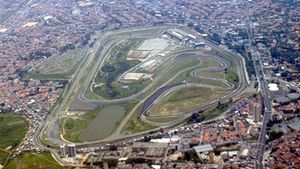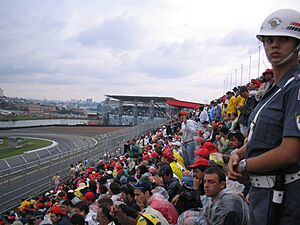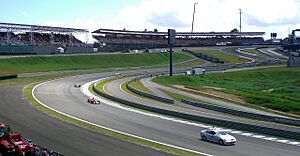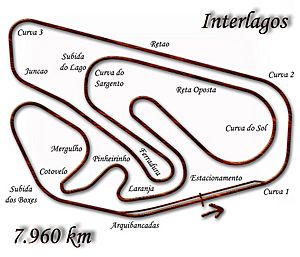Brazilian Grand Prix facts for kids
| Autódromo José Carlos Pace (Intermittently 1972–1980, 1990–present) |
|
 |
|
| Race information | |
|---|---|
| Number of times held | 52 |
| First held | 1972 |
| Most wins (drivers) | |
| Most wins (constructors) | |
| Circuit length | 4.309 km (2.677 mi) |
| Race length | 305.879 km (190.064 mi) |
| Laps | 71 |
| Last race (2024) | |
| Pole position | |
|
|
| Podium | |
|
|
| Fastest lap | |
|
|
The Brazilian Grand Prix, now called the São Paulo Grand Prix, is an exciting Formula One car race. It takes place at the Autódromo José Carlos Pace in the Interlagos area of São Paulo, Brazil. The first race was held in 1972. It became an official championship event in 1973. For a while, the race moved to Jacarepaguá in Rio de Janeiro from 1978 to 1989. Since 1990, it has been held back at Interlagos.
How Brazilian Grand Prix Racing Began
Car racing in Brazil started even before World War II. Early races happened on a street track called Gávea in Rio de Janeiro, beginning in 1934. Brazil's first permanent race track, Interlagos, was built in São Paulo. Construction started in 1936 and finished in 1940.
Interlagos quickly became known as a very challenging track. It had many difficult turns, changes in height, and a bumpy surface. Drivers had to be very skilled because there wasn't much room for mistakes.
Formula One Races in Brazil
Interlagos: The First Era
The first Brazilian Grand Prix happened at Interlagos in 1972. This race was a test to see if the track could host a Formula One World Championship event. The next year, in 1973, the race officially joined the Formula One calendar. Local hero Emerson Fittipaldi won that first official race. He won again in 1974. In 1975, another São Paulo driver, Carlos Pace, won the race.
However, by 1977, drivers started to complain about how bumpy the Interlagos track was. Because of these complaints, the race moved to a new track in Rio de Janeiro for a year.
The race returned to Interlagos in 1979 with some upgrades. But the track was still very bumpy. By 1980, the city of São Paulo had grown a lot. The area around the track looked a bit run-down, which didn't fit with Formula One's growing glamorous image. Drivers were also worried about safety on the bumpy track. So, the Formula One races moved back to Rio de Janeiro.
Jacarepaguá: Racing in Rio
In 1978, the Brazilian Grand Prix moved to Jacarepaguá in Rio de Janeiro. This track was flat but very demanding. It had long, fast corners and a rough surface. Because the race was held early in the season during Brazil's summer, it was often very hot and humid. This made the races incredibly tough for the drivers.
In 1981, Carlos Reutemann won, even though he was told to let his teammate win. The 1982 race was won by Alain Prost, who would become known as "the King of Rio" because he won there five times. Brazilian driver Nelson Piquet won in 1983 and 1986.
The 1988 race was special because Ayrton Senna started from the pit lane. He drove amazingly, moving up to second place. The 1989 event was the last race at Jacarepaguá. It was won by Nigel Mansell.
Interlagos: The Modern Era (1990-Present)
Because of the success of São Paulo native Ayrton Senna, city officials spent a lot of money to improve the Interlagos track. The track was made shorter and smoother. In 1990, the Grand Prix returned to Interlagos, and it has been held there ever since. Interlagos is now seen as one of the most exciting and challenging tracks in Formula One.
The first race back at the new Interlagos in 1990 was won by Alain Prost. This was his sixth win in Brazil. In 1991, Ayrton Senna won his first Brazilian Grand Prix. It was a very emotional win for him. His car was losing gears, and he was exhausted, but he still managed to win.
In 1993, Senna won again in the rain. The 1994 race was won by Michael Schumacher. Sadly, Senna passed away later that year in another race. The 1995 race was controversial but Michael Schumacher was eventually confirmed as the winner. Damon Hill won in 1996. In 1997, Jacques Villeneuve won after a restart. Mika Häkkinen won in 1998 and 1999. Michael Schumacher won again in 2000 and 2002.
The 2001 race saw the exciting arrival of Juan Pablo Montoya. He bravely overtook Michael Schumacher and led the race until an accident ended his day. Montoya later won the 2004 race.
The 2003 race was very chaotic due to heavy rain. Many drivers spun out, including Michael Schumacher. Giancarlo Fisichella was eventually declared the winner after some confusion. The 2004 race was the first time the Brazilian Grand Prix was not held at the beginning of the season.

In 2005, Fernando Alonso became the youngest Formula One World Champion. He finished third, which was enough to win the title. In 2006, the Brazilian Grand Prix hosted the final race of the season. Michael Schumacher had an amazing drive, moving from 10th to 4th place. Brazilian driver Felipe Massa won the race, making his home crowd very happy.
In 2007, Kimi Räikkönen won the race and his first championship. In 2008, Lewis Hamilton became the youngest Formula One World Champion at the time. He secured the title in the very last corner of the race.
The 2009 race saw Jenson Button win his only Drivers' Championship. In 2010, Sebastian Vettel won the race. He also won in 2013, setting a new record for nine wins in a row. This record was later broken by Max Verstappen in 2023.
In 2012, Sebastian Vettel won his third straight Drivers' title after a tough race. This race was also the last for the legendary Michael Schumacher. From 2014 to 2016, Mercedes cars dominated, with Nico Rosberg and Lewis Hamilton winning. In 2016, Max Verstappen showed incredible skill, driving from 16th to 3rd place in just 15 laps in heavy rain.
The contract for the Brazilian Grand Prix at Interlagos was extended until 2025. The 2020 race was cancelled due to the COVID-19 pandemic.
Renaming to São Paulo Grand Prix
Formula One returned to Interlagos in the 2021 season. The event was renamed the São Paulo Grand Prix. Lewis Hamilton won the main race in 2021 after starting from the back of the grid. In 2022, Lewis Hamilton's teammate, George Russell, won both the sprint race and the main race.
In 2023 and 2024, Max Verstappen won both races. In the 2024 São Paulo Grand Prix, Verstappen won from 17th place on the grid, which was an amazing achievement. This win helped him on his way to winning his fourth straight Drivers' Championship. The Alpine team also had a great race, with their drivers Esteban Ocon and Pierre Gasly finishing second and third.
Five Brazilian drivers have won the Brazilian Grand Prix: Emerson Fittipaldi, Nelson Piquet, Ayrton Senna, and Felipe Massa each won twice, and Carlos Pace won once. The driver with the most wins is Alain Prost, who won the race six times.
Talk of Returning to Rio
In 2019, there were talks about moving the Brazilian Grand Prix back to Rio de Janeiro. A new track was planned because the old Jacarepaguá circuit was demolished for the 2016 Summer Olympics. However, these plans were later cancelled. Formula 1 drivers, including Lewis Hamilton, also expressed concerns about the environmental impact of building a new track.
Winners
Drivers with Multiple Wins
Drivers in bold are currently competing in Formula One. A pink background means the race was not part of the Formula One World Championship.
| Wins | Driver | Years won |
|---|---|---|
| 6 | 1982, 1984, 1985, 1987, 1988, 1990 | |
| 4 | 1972, 1977, 1978, 1981 | |
| 1994, 1995, 2000, 2002 | ||
| 3 | 2010, 2013, 2017 | |
| 2016, 2018, 2021 | ||
| 2019, 2023, 2024 | ||
| 2 | 1973, 1974 | |
| 1983, 1986 | ||
| 1989, 1992 | ||
| 1991, 1993 | ||
| 1998, 1999 | ||
| 2004, 2005 | ||
| 2006, 2008 | ||
| 2009, 2011 | ||
| 2014, 2015 | ||
| Source: | ||
Winning Teams (Constructors)
Teams in bold are currently competing in Formula One. A pink background means the race was not part of the Formula One World Championship.
| Wins | Constructor | Years won |
|---|---|---|
| 12 | 1974, 1984, 1985, 1987, 1988, 1991, 1993, 1998, 1999, 2001, 2005, 2012 | |
| 11 | 1976, 1977, 1978, 1989, 1990, 2000, 2002, 2006, 2007, 2008, 2017 | |
| 7 | 2009, 2010, 2011, 2013, 2019, 2023, 2024 | |
| 6 | 1981, 1986, 1992, 1996, 1997, 2004 | |
| 2014, 2015, 2016, 2018, 2021, 2022 | ||
| 3 | 1972, 1975, 1983 | |
| 2 | 1980, 1982 | |
| 1994, 1995 | ||
| Source: | ||
Winning Engine Manufacturers
Manufacturers in bold are currently competing in Formula One. A pink background means the race was not part of the Formula One World Championship.
| Wins | Manufacturer | Years won |
|---|---|---|
| 11 | 1976, 1977, 1978, 1989, 1990, 2000, 2002, 2006, 2007, 2008, 2017 | |
| 1998, 1999, 2001, 2005, 2012, 2014, 2015, 2016, 2018, 2021, 2022 | ||
| 10 | 1980, 1982, 1992, 1995, 1996, 1997, 2009, 2010, 2011, 2013 | |
| 9 | 1972, 1973, 1974, 1975, 1979, 1981, 1993, 1994, 2003 | |
| 4 | 1986, 1988, 1991, 2019 | |
| 3 | 1984, 1985, 1987 | |
| 2 | 1983, 2004 | |
| 2023, 2024 | ||
| Source: | ||
* Built by Cosworth, funded by Ford
** Between 1998 and 2005 built by Ilmor, funded by Mercedes
*** Built by Porsche
Winners by Year
- A pink background means the race was not part of the Formula One World Championship.
- Since 2021 the event has been held under the name "São Paulo Grand Prix".
| Year | Driver | Constructor | Location | Report |
|---|---|---|---|---|
| 2021 | Mercedes | Interlagos | Report | |
| 2022 | Mercedes | Report | ||
| 2023 | Red Bull Racing-Honda RBPT | Report | ||
| 2024 | Red Bull Racing-Honda RBPT | Report | ||
| Source: | ||||
See also
 In Spanish: Gran Premio de Brasil para niños
In Spanish: Gran Premio de Brasil para niños







